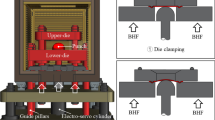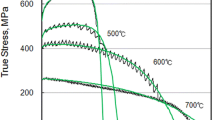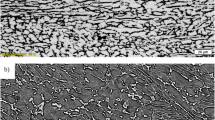Abstract
Hardening is the core factor to determine deformation uniformity in sheet metal forming. Hot deformation of titanium alloy sheets encounters the coupled effects of strain hardening, strain rate hardening and softening, which makes the determination of forming parameters aiming for an enhanced hardening very difficult in practical processes. This paper presents a new model to quantify the hardening of Ti-6Al-4 V titanium alloy sheets under hot forming conditions based on the underlying correlation between uniform strain and hardening. Firstly, to precisely determine hot deformation characteristics of titanium alloy sheets, hot tensile uniaxial tests using Gleeble systems at various strain rates of 0.01–1 s−1 and temperatures of 973–1123 K were performed systematically. A newly developed volume-based correction method for stress–strain curves of Gleeble thermo-mechanical testing was proposed to eliminate the damaging effect of temperature gradients on strain calculations, which enables the strain hardening, strain rate hardening and softening to be determined precisely. Then, a simple unified formula of hardening components (n, m and s) was proposed to predict the achievable uniform strain at certain conditions efficiently. Using which, occupation of each hardening can be quantified and compared to facilitate the determination of process parameters. Finally, a phenomenological model based on the hardening and softening components was developed to predict the hot flow behaviour. The proposed quantitative model can provide an efficient and useful approach for process designers to design process parameters driven by the objective of enhancing hardening to maximize uniform deformation during hot forming of titanium alloy sheets.











Similar content being viewed by others
Abbreviations
- \({S}_{NU}^{0}\) (mm2):
-
Initial cross-section area of non-uniform temperature zone
- \({L}_{NU}^{0}\) (mm):
-
Initial length of non-uniform temperature zone
- \({S}_{NU}^{i}\) (mm2):
-
Instant interface area of between uniform and non-uniform temperature zones
- \({L}_{NU}^{i}\) (mm):
-
Instant length of non-uniform temperature zone
- \({S}_{NU}^{I}\) (mm2):
-
Deformed interface area of between uniform and non-uniform temperature zones
- \({L}_{NU}^{I}\) (mm):
-
Deformed length of non-uniform temperature zones
- \(i\) :
-
Instantaneous time interval
- \(I\) :
-
Total number of time intervals of deformation
- \({L}^{i}\) (mm):
-
Instantaneous length of parallel zone
- \({L}_{U}^{i}\) (mm):
-
Instantaneous gauge length
- \({\sigma }_{i}\) (MPa):
-
Instantaneous true stress
- \({P}_{i}\) (N):
-
Instantaneous deformation force
- \({L}_{U}^{0}\) (mm):
-
Initial gauge length
- \({\varepsilon }_{i}\) :
-
Instantaneous true strain
- \(\sigma\) (MPa):
-
True stress
- \(K\) :
-
Strength coefficient
- \(n\) :
-
Strain hardening exponent
- \(\varepsilon\) :
-
True strain
- \({\varepsilon }_{DN}\) :
-
Strain of diffuse necking
- \({\varepsilon }_{LN}\) :
-
Strain of localized necking
- \(m\) :
-
Strain rate hardening component
- \(\dot{\varepsilon }\) (s− 1):
-
Strain rate
- \(s\) :
-
Softening exponent
- \({\varepsilon }_{\text{u}}\) :
-
Uniform strain
- \({\dot{\varepsilon }}^{*}\) (s− 1):
-
Reference strain rate
- \(R\) :
-
Correlation coefficient
- \(AARE\) :
-
Absolute average relative error
- \({E}_{i}\) :
-
Experimental data
- \({P}_{i}\) :
-
Predicted data
- Rest symbols:
-
Material constants
References
Sotto M, Longère P, Doquet V, Papasidero J (2020) A constitutive model for a rate and temperature-dependent, plastically anisotropic titanium alloy. Int J Plast 134(8):102777. https://doi.org/10.1016/j.ijplas.2020.102777
Chang ZD, Chen J (2022) Investigations on the forming characteristics of a novel flexible incremental sheet forming method for low-ductility metals at room temperature. J Mater Process Tech 301:117456. https://doi.org/10.1016/j.jmatprotec.2021.117456
Yasmeen T, Shao ZT, Zhao L, Gao P, Lin JG, Jiang J (2019) Constitutive modelling for the simulation of the superplastic forming of TA15 titanium alloy. Int J Mech Sci 164(12):105178. https://doi.org/10.1016/j.ijmecsci.2019.105178
Yasmeen T, Zhao B, Zheng JH, Tian FM, Lin JG, Jiang J (2020) The study of flow behavior and governing mechanisms of a titanium alloy during superplastic forming. Mat Sci Eng A-Struct 788:139482. https://doi.org/10.1016/j.msea.2020.139482
Luo J, Li MQ, Yu WX, Li H (2010) The variation of strain rate sensitivity exponent and strain hardening exponent in isothermal compression of Ti-6Al-4V alloy. Mater Design 31(2):741–748. https://doi.org/10.1016/j.matdes.2009.09.055
Considère A (1885) Mémoire sur l’emploi du fer et de l’acier dans les constructions: ii. Des Ponts Chaussées 574–775
Hart EW (1967) Theory of the tensile test. Acta Metall 15(2):351–355. https://doi.org/10.1016/0001-6160(67)90211-8
Ghosh AK (1977) The influence of strain hardening and strain-rate sensitivity on sheet metal forming. J Eng Mater Technol 99(3):264. https://doi.org/10.1115/1.3443530
Wang YM, Chen MW, Zhou FH, Ma E (2003) High tensile ductility in a nanostructured metal. Nature 419(6910):912–915. https://doi.org/10.1038/nature01133
Liu XC, Kopec M, Fakir OE, Qu HT, Wang YQ, Wang LL, Li ZQ (2020) Characterisation of the interfacial heat transfer coefficient in hot stamping of titanium alloys. Int Commun Heat Mass 113:104535. https://doi.org/10.1016/j.icheatmasstransfer.2020.104535
Wang KH, Shi CY, Zhu SQ, Wang TM, Shi JT, Liu G (2020) hot gas pressure forming of Ti-55 high temperature titanium alloy tubular component. Materials 13(20):4636. https://doi.org/10.3390/ma13204636
Zheng ZB, Balint DS, Dunne FPE (2016) Rate sensitivity in discrete dislocation plasticity in hexagonal close-packed crystals. Acta Mater 107:17–26. https://doi.org/10.1016/j.actamat.2016.01.035
Alabort E, Putman D, Reed RC (2015) Superplasticity in Ti-6Al-4V: characterisation, modelling and applications. Acta Mater 95:428–442. https://doi.org/10.1016/j.actamat.2015.04.056
Zhu YC, Fan JX, Li ZL, Luo YY, Niu Y (2021) Study of strain rate sensitivity exponent and strain hardening exponent of typical titanium alloys. Mater Today Commun 30(3):103060. https://doi.org/10.1016/j.mtcomm.2021.103060
Dang KX, Wang KH, Liu G (2021) Dynamic softening and hardening behavior and the micro-mechanism of a TC31 high temperature titanium alloy sheet within hot deformation. Materials 14(21):6515. https://doi.org/10.3390/ma14216515
Shao ZT, Li N, Lin JG, Dean TA (2017) Strain measurement and error analysis in thermo-mechanical tensile tests of sheet metals for hot stamping applications. P I Mech Eng C-J Mec 095440621771401. https://doi.org/10.1177/0954406217714011
Li N, Sun CY, Guo N, Mohamed M, Lin JG, Matsumoto T, Liu C (2016) Experimental investigation of boron steel at hot stamping conditions. J Mater Process Tech 228(2):2–10. https://doi.org/10.1016/j.jmatprotec.2015.09.043
Xiao WC, Wang BY, Zheng KL (2017) An experimental and numerical investigation on the formability of AA7075 sheet in hot stamping condition. Int J Adv Manuf Tech 92(9):3299–3309. https://doi.org/10.1007/s00170-017-0419-6
Mu YH, Zhou J, Wang BY, Wang QL, Ghiotti A, Bruschi S (2018) Numerical simulation of hot stamping by partition heating based on advanced constitutive modelling of 22MnB5 behaviour. Finite Elem Anal Des 147(8):34–44. https://doi.org/10.1016/j.finel.2018.05.005
Hill R (1952) On discontinuous plastic states, with special reference to localized necking in thin sheets. J Mech Phys Solids 1(1):19–30. https://doi.org/10.1016/0022-5096(52)90003-3
Lian JS, Zhou DJ (1989) Diffuse necking and localized necking under plane stress. Mat Sci Eng A-Struct 111:1–7. https://doi.org/10.1016/0921-5093(89)90191-3
Bressan JD (2011) New modelling of localized necking in sheet metal stretching. Am Inst Phys, AIP Conference Proceedings 1315:401–406. https://doi.org/10.1063/1.3552478
Rocha ABD, Barlat F, Jalinier JM (1985) Prediction of the forming limit diagrams of anisotropic sheets in linear and non-linear loading. Mat Sci Eng 68(2):151–164. https://doi.org/10.1016/0025-5416(85)90404-5
Lin YC, Chen XM (2011) A critical review of experimental results and constitutive descriptions for metals and alloys in hot working. Mater Design 32(4):1733–1759. https://doi.org/10.1016/j.matdes.2010.11.048
Bai Q, Lin J, Dean TA, Balint DS, Gao T, Zhang Z (2013) Modelling of dominant softening mechanisms for Ti-6Al-4V in steady state hot forming conditions. Mat Sci Eng A-Struct 559(1):352–358. https://doi.org/10.1016/j.msea.2012.08.110
Yasmeen T, Shao ZT, Zhao L, Gao P, Lin JG, Jiang J (2019) Constitutive modelling for the simulation of the superplastic forming of TA15 titanium alloy. Int Mech Sci 164(12):105178. https://doi.org/10.1016/j.ijmecsci.2019.105178
Yu RH, Li X, Li WJ, Chen JT, Guo X, Li JH (2021) Application of four different models for predicting the high-temperature flow behavior of TG6 titanium alloy. Mater Today Commun 26(3):102004. https://doi.org/10.1016/j.mtcomm.2020.102004
Sun JZ, Li MQ, Li H (2017) Interaction effect between alpha and beta phases based on dynamic recrystallization of isothermally compressed Ti-5Al-2Sn-2Zr-4Mo-4Cr with basketweave microstructure. J Alloy Compd 692(1):403–412. https://doi.org/10.1016/j.jallcom.2016.09.065
Xu RR, Li H, Li MQ (2020) Dynamic recrystallization mechanism of γ and α phases during the isothermal compression of γ-TiAl alloy with duplex structure. J Alloy Compd 844(12):156089. https://doi.org/10.1016/j.jallcom.2020.156089
Kopec M, Wang KH, Politis DJ, Wang YQ, Wang LL, Lin JG (2018) Formability and microstructure evolution mechanisms of Ti6Al4V alloy during a novel hot stamping process. Mat Sci Eng A-Struct 719(3):72–81. https://doi.org/10.1016/j.msea.2018.02.038
Yang QY, Deng ZH, Zhang ZQ, Liu Q, Jia ZH, Huang GJ (2016) Effects of strain rate on flow stress behavior and dynamic recrystallization mechanism of Al-Zn-Mg-Cu aluminum alloy during hot deformation. Mat Sci Eng A-Struct 662(4):204–213. https://doi.org/10.1016/j.msea.2016.03.027
Gourdet S, Montheillet F (2002) Effects of dynamic grain boundary migration during the hot compression of high stacking fault energy metals. Acta Mater 50(11):2801–2812. https://doi.org/10.1016/S1359-6454(02)00098-8
Yang YB, Zhang ZM, Li XB, Qiang W, Zhang YH (2013) The effects of grain size on the hot deformation and processing map for 7075 aluminum alloy. Mater Design 51(10):592–597. https://doi.org/10.1016/j.matdes.2013.04.034
Ghosh AK, Hamilton CH (1979) Mechanical behavior and hardening characteristics of a superplastic Ti-6AI-4V alloy. Metall Mater Trans A 10(6):699–706. https://doi.org/10.1007/BF02658391
Funding
The authors would like to thank the funding support by the National Natural Science Foundation of China (Grant No. 5200052525) and the Fundamental Research Funds for the Central Universities under the Grant Agreement DUT20RC(3)012.
Author information
Authors and Affiliations
Contributions
Kunning Fu: conceptualization, methodology, writing — original draft preparation, experimental scheme design. Heli Peng: Writing — reviewing and Editing. Kailun Zheng: conceptualization, validation, funding acquisition. Shijian Yuan: supervision.
Corresponding author
Ethics declarations
Ethical approval
Not applicable.
Consent to participate
All authors agreed to participate in this research.
Consent for publication
All authors have read and agreed to the published version of the manuscript.
Competing interests
The authors declare no competing interests.
Additional information
Publisher's note
Springer Nature remains neutral with regard to jurisdictional claims in published maps and institutional affiliations.
Rights and permissions
Springer Nature or its licensor (e.g. a society or other partner) holds exclusive rights to this article under a publishing agreement with the author(s) or other rightsholder(s); author self-archiving of the accepted manuscript version of this article is solely governed by the terms of such publishing agreement and applicable law.
About this article
Cite this article
Fu, K., Peng, H., Zheng, K. et al. Phenomenological model of hardening and flow for Ti-6Al-4 V titanium alloy sheets under hot forming conditions. Int J Adv Manuf Technol 125, 91–103 (2023). https://doi.org/10.1007/s00170-022-10629-x
Received:
Accepted:
Published:
Issue Date:
DOI: https://doi.org/10.1007/s00170-022-10629-x




